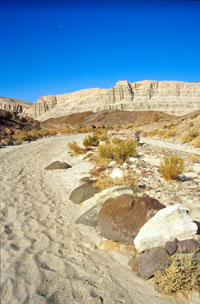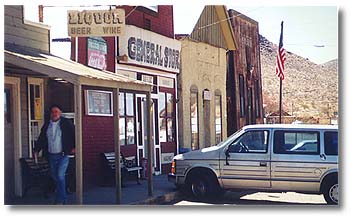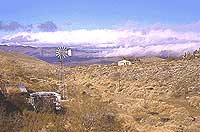Astro 28M: Field Astronomy from the High Desert:
Two Lunar Grazes
Apr 15-17, 2005
Check the
Post Trip Highlights page!
 We're going to the desert! The goal is to explore planetary surfaces and the
processes which shape them. We will study the moon and its dark profile by video
recording lunar grazing occultations; we get a
We're going to the desert! The goal is to explore planetary surfaces and the
processes which shape them. We will study the moon and its dark profile by video
recording lunar grazing occultations; we get a rare opportunity to get two bright lunar grazes in a single weekend from the
same area. What's a graze, you ask? Check
it out! Read more about our grazes
here.
rare opportunity to get two bright lunar grazes in a single weekend from the
same area. What's a graze, you ask? Check
it out! Read more about our grazes
here.
We will plan to camp this weekend in Red
Rock Canyon State Park in the El Paso Mountains area of the western
Mojave, just over the pass from Bakersfield. Read more about this beautiful
state park here.
The desert is not only a great place for astronomy, but also is an ideal location
for learning about the processes that mold the crusts of the  inner
planets - faulting, volcanism, metemorphism, erosion. As always, this class
will feature some great cooking by yours truely - my now famous french crepes
breakfasts and an equally delicous dinner, to be enjoyed around the campfire
while I lecture on the moon, planets, stars, galaxies, and the formation of
the universe.
inner
planets - faulting, volcanism, metemorphism, erosion. As always, this class
will feature some great cooking by yours truely - my now famous french crepes
breakfasts and an equally delicous dinner, to be enjoyed around the campfire
while I lecture on the moon, planets, stars, galaxies, and the formation of
the universe.
During the day, we'll use the fault-carved and mineral-rich local environs
as a setting to help explain the evolutionary processes that shape the earth
and the inner planets in general.
 Randsburg
is one of the most interesting old mining towns of the Mojave Desert. It is
about 50 miles northeast of the town of Mojave, perched on the side of a mountain
range which reaches over 5,000ft. It's glory days as a gold mining town over
100 years ago are long gone, but there is still a tiny population in this interesting
little town with one main street and a few old homes dotting the hillsides.
It caters mostly to desert explorers now, although a little mining is still
happening in the area.
Randsburg
is one of the most interesting old mining towns of the Mojave Desert. It is
about 50 miles northeast of the town of Mojave, perched on the side of a mountain
range which reaches over 5,000ft. It's glory days as a gold mining town over
100 years ago are long gone, but there is still a tiny population in this interesting
little town with one main street and a few old homes dotting the hillsides.
It caters mostly to desert explorers now, although a little mining is still
happening in the area.
 Randsburg
has a panoramic view of the Garlock Valley, which is a graben formed by the
Garlock Fault
- a rare transverse fault - spreading apart the El
Paso Mountains on the north side and the Rand Mountains on the
south. It is home to the
Desert Tortoise Natural area, to Koehn
Dry Lake, and is adjacent to the oxide-colored red cliffs of Red
Rock Canyon State Park - a frequent and time-tested destination
for these Cabrillo astronomy trips. BLM land dominates this area and primitive
camping is allowed in many areas. Read more about Randsburg here.
Randsburg
has a panoramic view of the Garlock Valley, which is a graben formed by the
Garlock Fault
- a rare transverse fault - spreading apart the El
Paso Mountains on the north side and the Rand Mountains on the
south. It is home to the
Desert Tortoise Natural area, to Koehn
Dry Lake, and is adjacent to the oxide-colored red cliffs of Red
Rock Canyon State Park - a frequent and time-tested destination
for these Cabrillo astronomy trips. BLM land dominates this area and primitive
camping is allowed in many areas. Read more about Randsburg here.
Registering for the class...
The initial sign-up day, Feb 9, is now past. The class filled, and there is
a waiting list of 8. If you want me to add your name to the wait list, call
me (479-6506) or email me. If it turns out that a space opens up for you, there
is a $15 camping fee, and upon receipt of the fee, I will have our division
personnel approve your name in the Admin&Records computer to allow you to
register for the class. I'm easiest to reach if you come by my office at 706a
at 11am sharp on Monday or Wednesday.
There is, as always, an on-campus session before the trip. It's on Wednesday
afternoon April 6 at 5pm in Room 706 - the Cabrillo College Planetarium.
At this session we'll arrange car pools, distribute maps and detailed instructions.
I'll also have a lecture and planetarium show with slides. I love cooking great
meals for my classes, but new rules imposed by state codes, forbids me to buy
your food. So, I'll have a list of the ingredients, and we'll find volunteers
or perhaps a single 'shopping czar' to buy what we'll need. Note that the on-campus
first meeting of the class is one week before the date in the schedule of classes.
This is by universal agreement at the sign-up session. It will be good to have
an extra week for students to get together to buy the food.
Update Mar. 3, 2005
Red Rock Canyon State Park has taken itself off the ReserveAmerica reservation
system. It's first-come / first-served camping. So, given this is a prime Spring
weekend for L.A.liens, we should try and get one or two cars to arrive as early
on Friday as possible to snag 4 campsites. Note that we will want the 4 sites
that are farthest south on the camp loop. Given it's a one-way drive, those
are the last 4 sites you come to. These are by far the best for doing astronomy
from and also get access to the local desert wonders. Any volunteers?
back to Rick's home page
 We're going to the desert! The goal is to explore planetary surfaces and the
processes which shape them. We will study the moon and its dark profile by video
recording lunar grazing occultations; we get a
We're going to the desert! The goal is to explore planetary surfaces and the
processes which shape them. We will study the moon and its dark profile by video
recording lunar grazing occultations; we get a rare opportunity to get two bright lunar grazes in a single weekend from the
same area. What's a graze, you ask? Check
it out! Read more about our grazes
here.
rare opportunity to get two bright lunar grazes in a single weekend from the
same area. What's a graze, you ask? Check
it out! Read more about our grazes
here. inner
planets - faulting, volcanism, metemorphism, erosion. As always, this class
will feature some great cooking by yours truely - my now famous french crepes
breakfasts and an equally delicous dinner, to be enjoyed around the campfire
while I lecture on the moon, planets, stars, galaxies, and the formation of
the universe.
inner
planets - faulting, volcanism, metemorphism, erosion. As always, this class
will feature some great cooking by yours truely - my now famous french crepes
breakfasts and an equally delicous dinner, to be enjoyed around the campfire
while I lecture on the moon, planets, stars, galaxies, and the formation of
the universe. Randsburg
Randsburg